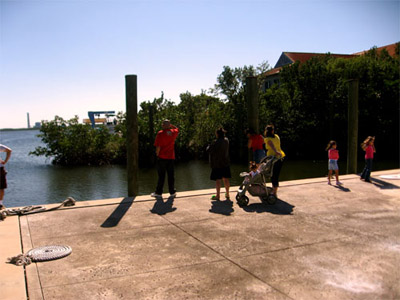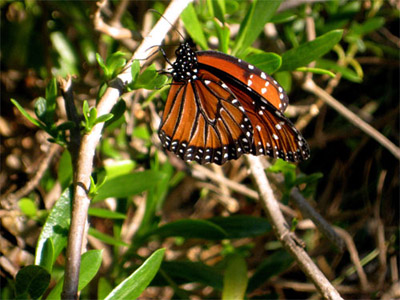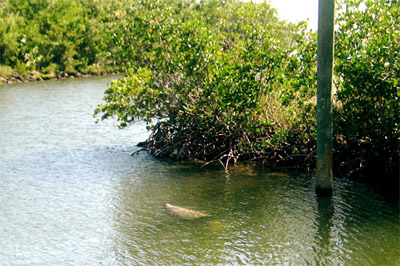
Park offers activities at no cost to visitors
HOMESTEAD, Fla.— Just less than 20 miles from the University of Miami and its Coral Gables campus, the drive to Biscayne National Park may seem like a hike for college students. But when nights in Coconut Grove or South Beach start to get dull (and expensive!), the park offers a quiet escape from college life— and you won’t have to spend a dime.
Several activities at Biscayne National Park give visitors insight into the local wildlife and history for absolutely no cost. These are just a few ways to take a break from the library and enjoy what Miami has to offer without ever getting out your wallet.
 |
A family watches a manatee swim through the shallow waters near the Dante Fascell Visitor Center (Photo by Blair Brett- schneider). |
Go for a walk
Although most of the park is formed by much of Biscayne Bay and is underwater, there are plenty of activities that will allow you to stay dry. The short (1/4 mile) jetty trail that begins at Convoy Point offers a great views of the Miami skyline and Key Biscayne on a clear day, as well as opportunities to spot many species of fish, and other wildlife such as butterflies and birds.
Bring a picnic
The picnic tables, located on the water just outside the Dante Fascell Visitor Center and just seconds from the jetty trail, are ideal for an outdoor lunch. Pack a brown bag lunch or bring food to cook on the grills, conveniently located in the picnic area. The Visitor Center also includes vending machines in case of a sudden sweet tooth. Just be sure to use the trash receptacles afterward to keep the park clean for other visitors.
Stay indoors
If typical Miami tropical weather kicks in and you find yourself stuck in the rain, head inside and wait out the storm while taking advantage of more park activities. Inside the Visitor Center, you can walk through the small museum that includes exhibits about Biscayne’s various ecosystems. Films are also available to explain more about the wildlife and history of Biscayne National Park.
For art enthusiasts, the Visitor Center Gallery highlights the work of artists dedicated to the preservation of Biscayne National Park and other natural areas. Such artists include Bill Goodwin, the latest winner of the International Coral Reef Symposium Photo Contest. Goodwin’s winning photograph of a Nassau grouper is credited with contributing to the passing of Grand Cayman legislature prohibiting grouper spear fishing. Photographs from the contest are on display in the Visitor Center Gallery until Feb. 22, 2009.
| The short jetty trail is a great place to spot birds, fish, and butterflies such as this one (Photo by Blair Brettschneider). |  |
Talk to a ranger
When it comes to learning about all that Biscayne has to offer, the park rangers are excellent resources. Not only will they help you plan your day at the park, but they may also have interesting stories to tell.
“The most impressive thing I have seen at the park is probably a manatee,” said Park Ranger Emma Andrews as she stands behind the information desk.
She then thinks for a moment and changes her mind.
“Well, I used to have this dog named Chopper. One day we were going out on a boat tour at Everglades [National Park] and he was playing on the dock.” She recalls how she turned around to discover that her pitbull had been eaten by an alligator. “So maybe that’s the most impressive thing I’ve seen.”
Luckily, there are more fish and birds around the Visitor Center than alligators and visitors need not worry about being suddenly attacked on the jetty trail.
A schedule of ranger-led tours and activities is available on the Biscayne National Park website.
Watch for wildlife
Looking for animal species is one of the most exciting parts of visiting the park. Park officials do not know the exact number of manatees that inhabit Biscayne National Park and the total number of manatees in Florida is also difficult to estimate. They can occasionally be spotted at the park, however, most likely in the shallow waters near the boat docks.
Along with simply looking for wildlife, many visitors travel to Biscayne National Park to go fishing. Fishing off of the jetty or boardwalk is free, and no license is required for fishing from land. Biscayne also offers a free Fisheries Awareness Class to educate visitors about fishing in the park. The class includes information on fishing regulations, identifying a catch, and techniques, and is held on the third Wednesday of every month from 6 p.m. to 9:30 p.m. at Suniland Park in Pinecrest.
 |
A manatee comes up for air (Photo by Blair Brett-schneider). |
On a Sunday afternoon in November, one family visiting the park is lucky enough to see a manatee swimming in the shallow waters near the Visitor Center. It comes up for air several times before slowly gliding away from the dock and out of sight. The visitors report the manatee sighting to Andrews at the information desk.
“You saw one just now?” she asks excitedly. “Great! Come right over here and fill out this sighting log!” The guests write in their manatee sighting in a book at the desk, proud to have become a part of Biscayne history.
If money is no object
For those with money to spend, Biscayne offers many outdoor activities. Kayak rental is $16, and canoe rental runs at $12. Keep in mind that weather is key to water activities, and on a windy day, kayaks and canoes may not be available if the water is too rough.
Camping is an option on Boca Chita Key and Elliott Key. Those with private boats can access these camp sites year round, however the park’s concessioner provides transportation to the islands during the winter and spring for a fee. The cost of camping runs from $15 per night, to $30 per night with a group.
If You Go
Dante Fascell Visitor Center
9700 SW 328th St., Homestead, Fla. 33033
Open daily 9 a.m. to 5 p.m.
Total cost = No admission or parking fees
Total time = two to four hours
Visitor information 305-230-7275
http://www.nps.gov/bisc/

Comments are Closed